Living in a small space has become increasingly common in today’s urban landscape, but that doesn’t mean you have to compromise on style or comfort. Your compact living room can be transformed into an aesthetically pleasing and functional sanctuary with the right approach.
Whether you’re dealing with an intimate apartment space or a modest living area in your home, the key lies in implementing ingenious solutions that maximize every square foot.
We’ve curated a comprehensive collection of 30 small living room ideas that blend practicality with sophistication. These strategies go beyond basic decorating tips, offering innovative approaches to space optimization and multifunctional design.
From clever furniture arrangements to architectural illusions that create an ethereal sense of space, each idea has been carefully selected to help you make the most of your living area.
Small Living Room Ideas
Whether you’re starting fresh or looking to revitalize your existing space, these ideas will guide you in creating a living room that feels both spacious and welcoming, proving that limited square footage can still yield unlimited potential.
Smart Furniture Choices
1. Multi-functional Furniture

The cornerstone of any small living room is furniture that serves multiple purposes. Consider ottomans with hidden storage compartments that can act as both seating and storage space. These versatile pieces can hide away extra blankets, magazines, or gaming controllers while providing additional seating when guests arrive.
When selecting multi-functional furniture, focus on pieces that seamlessly transition between roles. A coffee table that doubles as a work desk, or a sofa that converts into a comfortable bed for overnight guests can be game-changers in a small space.
2. Wall-mounted Solutions

Free up valuable floor space by taking advantage of your walls. Wall-mounted shelves, TV units, and even fold-down desks can create a floating effect that makes your room appear larger. This approach not only saves space but also adds a contemporary touch to your living room.
Consider installing adjustable wall-mounted lighting fixtures instead of floor lamps, and opt for wall-mounted magazine racks or book shelves. These choices help maintain an open floor plan while keeping essential items within easy reach.
3. Modular Seating

Embrace the flexibility of modular furniture that can be rearranged to suit different occasions. Sectional sofas that can be separated into individual seats or combined for larger gatherings provide versatility in small spaces.
Look for lightweight pieces that can be easily moved and reconfigured. This adaptability allows you to transform your living room from an intimate conversation area to an entertainment space without the need for additional furniture.
Clever Storage Solutions
4. Built-in Shelving
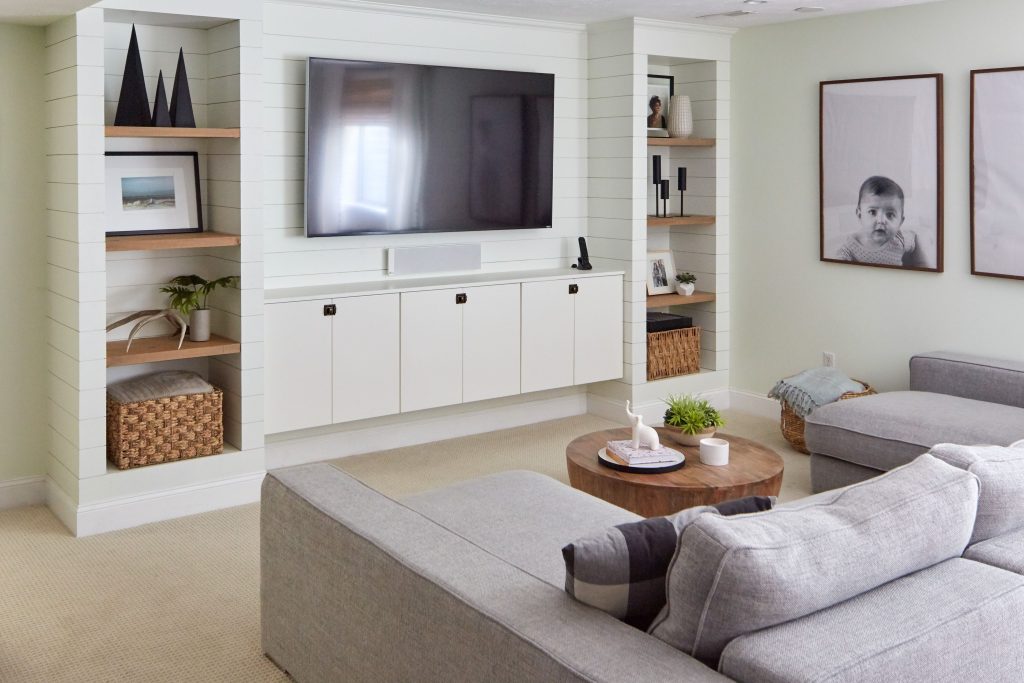
Custom built-in shelving maximizes vertical space while providing a sleek, integrated look. Floor-to-ceiling shelving units can house books, decorative items, and entertainment systems without consuming precious floor space.
Consider incorporating a mix of open and closed storage options within your built-ins. This combination allows you to display cherished items while hiding away less attractive necessities, maintaining a clean and organized appearance.
5. Under-furniture Storage
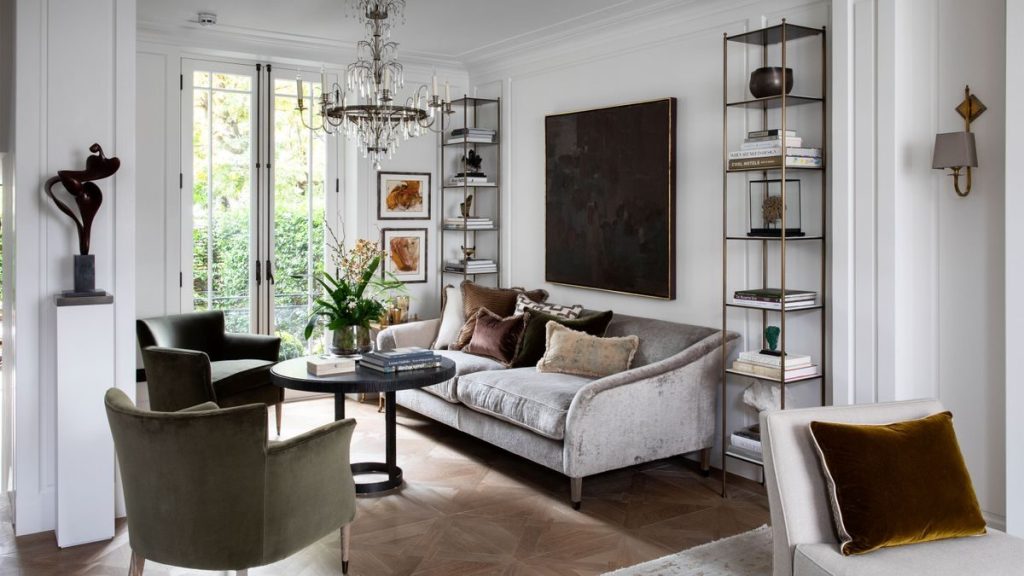
Make use of every available inch by choosing furniture with built-in storage or adequate clearance underneath. Sofas and chairs with storage compartments underneath can house seasonal items or extra bedding.
Look for coffee tables with drawers or shelves, and consider bed risers for furniture pieces to create additional storage space beneath. These hidden storage solutions help maintain a clutter-free environment without sacrificing style.
Optical Illusions and Visual Tricks
6. Strategic Mirror Placement
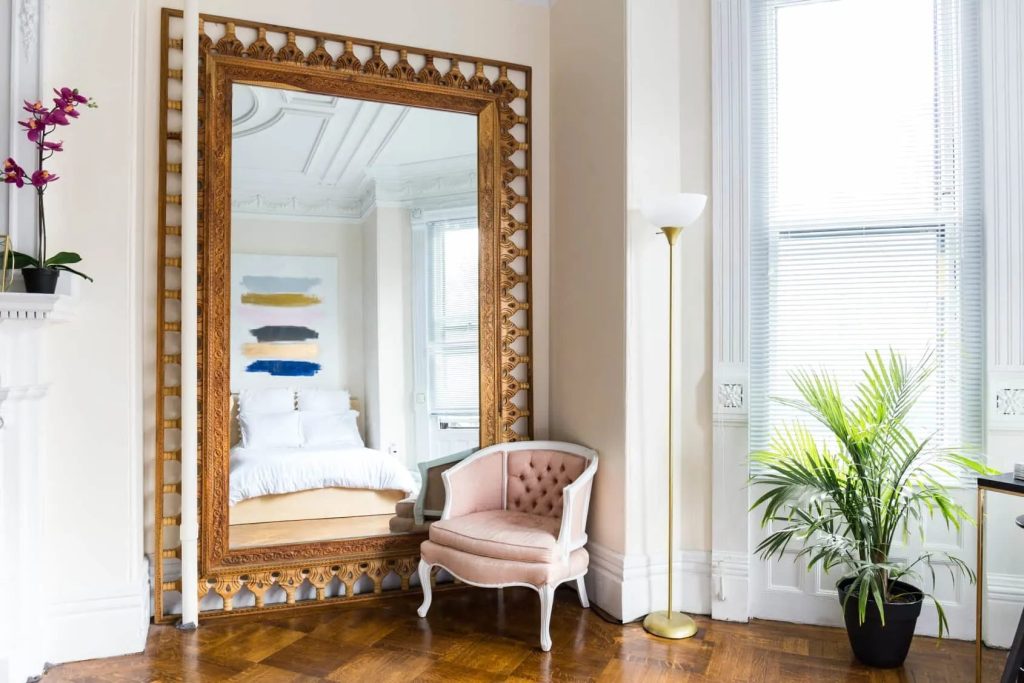
Mirrors are powerful tools for creating the illusion of space. Position large mirrors opposite windows to reflect natural light and make your room appear twice its size. Consider installing a gallery wall of smaller mirrors for a decorative touch that serves a practical purpose.
Experiment with different mirror shapes and frames to add visual interest while maintaining the space-enhancing effect. Floor-to-ceiling mirrors can dramatically increase the perceived height of your room.
7. Light Colors and Patterns

Choose a light, cohesive color palette to create an airy, open feeling. Soft whites, creams, and pale pastels reflect light and make walls appear to recede, while strategic pops of color add personality without overwhelming the space.
When incorporating patterns, opt for vertical stripes or small-scale designs that draw the eye upward. This technique creates the illusion of higher ceilings and adds visual interest without cluttering the space.
Lighting Techniques
8. Layered Lighting

Implement a mix of lighting sources to create depth and ambiance. Combine overhead lighting with task lighting and accent lights to highlight different areas of your room and create distinct zones for various activities.
Use dimmers to adjust lighting levels throughout the day, and consider LED strip lighting under shelving or behind furniture to add a subtle glow that makes your space feel larger and more inviting.
9. Natural Light Optimization

Maximize natural light by keeping windows unobstructed and using light, sheer curtains that allow sunlight to filter through. Position furniture to take advantage of natural light while maintaining clear pathways.
Consider using metallic accents or glass furniture pieces that reflect light and contribute to a brighter, more open atmosphere. Remove heavy window treatments that block natural light and replace them with minimal options that maintain privacy without sacrificing brightness.
Space-saving Layout Strategies
10. Corner Arrangements

Make the most of corner spaces by positioning larger furniture pieces at angles. A corner sofa or entertainment unit can maximize seating or storage while maintaining open pathways through the room.
Consider creating a cozy reading nook or home office space in an unused corner. This approach helps define separate areas within your living room without using physical dividers.
Related Guide: 30 Inspiring Earthy Living Room Ideas
11. Floating Furniture

Pull furniture slightly away from walls to create the illusion of more space. This counterintuitive approach actually makes a room feel larger by creating subtle breathing room around each piece.
Ensure there are clear pathways between furniture pieces, and avoid pushing all furniture against walls, which can make a room feel cramped and confined.
Design Elements and Accessories
12. Vertical Garden Features
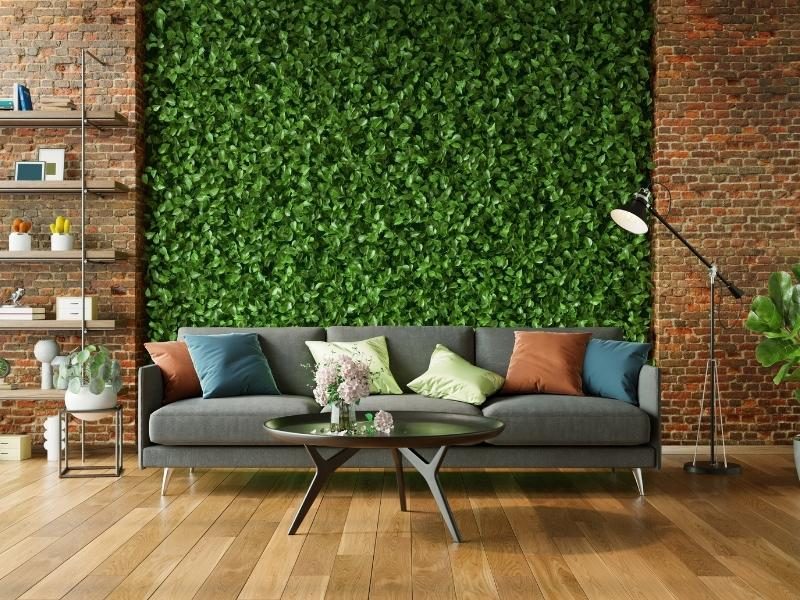
Bring life to your small living room with vertical gardens or hanging plants. These natural elements add visual interest and improve air quality without consuming valuable floor space.
Select low-maintenance plants that thrive in indoor conditions, and consider using hanging planters or wall-mounted containers to create a living wall effect.
13. Statement Art Pieces

Choose one or two large art pieces rather than multiple small ones to create a focal point without cluttering walls. Large-scale artwork can make a room feel more spacious by drawing the eye upward.
Position artwork at eye level or slightly above to create visual interest and establish a sense of height in the room. Avoid cluttering walls with too many small pieces, which can make the space feel busy and confined.
14. Minimalist Decor Approach

Embrace the “less is more” philosophy by selecting fewer, but more impactful decorative pieces. Choose items that tell a story or hold special meaning rather than filling spaces with generic decorations that can make your room feel cluttered.
When selecting decorative items, consider their scale and proportion to the room. Opt for pieces that complement your space without overwhelming it, and rotate seasonal decorations rather than displaying everything at once.
15. Area Rug Placement

Use appropriately sized area rugs to define different zones within your living room while maintaining visual continuity. A well-placed rug can anchor furniture groupings and add warmth without making the space feel cramped.
Choose rugs with simple patterns or solid colors that complement your overall design scheme. Consider layering smaller rugs over larger, neutral ones to add depth and interest while maintaining a cohesive look.
Smart Technology Integration
16. Hidden Entertainment Systems

Invest in smart TVs that can display art when not in use, or consider projector systems that can be completely hidden when not needed. This approach helps maintain a clean, sophisticated look while providing modern entertainment options.
Look for wireless speakers and minimal cable solutions to reduce visual clutter. Consider furniture pieces with built-in charging stations and cable management systems to keep technology accessible but discreet.
17. Voice-Controlled Features

Incorporate smart home devices that can control lighting, temperature, and entertainment systems without the need for multiple remote controls or switches. This technology can help reduce physical clutter while increasing functionality.
Choose devices that complement your decor and can be easily integrated into your existing setup. Consider smart plugs and outlets that can control multiple devices while remaining hidden from view.
Color and Texture Strategies
18. Monochromatic Color Schemes

Create depth and interest using different shades and tones of the same color. This approach provides visual continuity while adding sophisticated layers to your design without overwhelming the space.
Incorporate various textures within your chosen color palette to add dimension and prevent the space from feeling flat. Use throw pillows, curtains, and rugs to introduce different materials and finishes.
19. Strategic Color Blocking

Use color blocking techniques to define different areas within your living room while maintaining a cohesive look. This can be achieved through painted accent walls, furniture pieces, or decorative accessories.
Consider using complementary colors that create visual interest without competing for attention. Keep the overall palette limited to prevent the space from feeling chaotic.
Furniture Arrangement Techniques
20. Conversation Areas

Create intimate seating arrangements that encourage conversation while maintaining open traffic flow. Position seating pieces to face each other at comfortable distances, even in limited space.
Use smaller accent chairs or poufs that can be easily moved to accommodate different group sizes. This flexibility allows you to maintain an open feel while providing adequate seating when needed.
Related Guide: 20 Creative Earthy Bathroom Ideas
21. Entry Flow
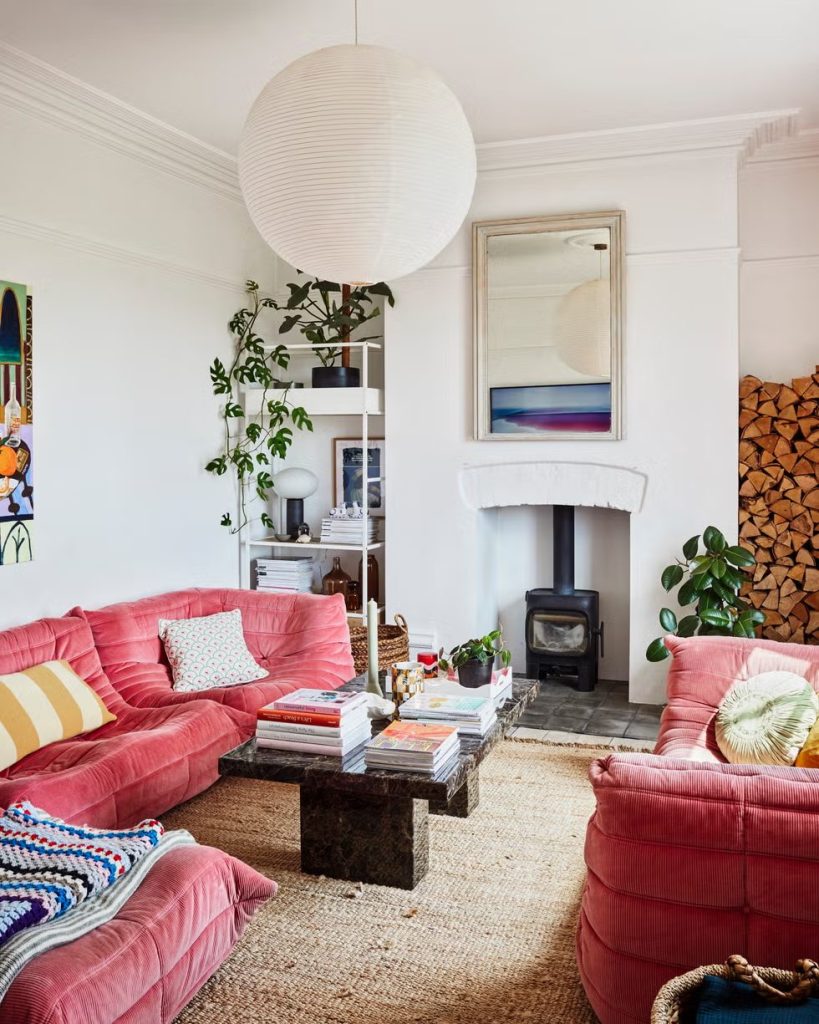
Design a clear pathway from your entrance that doesn’t interrupt the living room’s functionality. Consider furniture placement that guides movement through the space naturally.
Use console tables or slim storage solutions near entryways to create a transition zone without blocking traffic flow. This helps maintain organization while maximizing usable living space.
Architectural Elements
22. Window Treatments

Choose window treatments that extend from floor to ceiling to create the illusion of taller walls. Mount curtain rods close to the ceiling and let drapes fall to the floor for maximum impact.
Select light-filtering options that provide privacy without completely blocking natural light. Consider motorized blinds or shades that can be completely hidden when not in use.
23. Room Dividers

Use decorative screens or open shelving units to create distinct areas within your living room without building permanent walls. These flexible solutions can be moved or adjusted as needed.
Look for dividers that serve multiple purposes, such as providing storage or displaying artwork. Consider using plants or hanging macramé pieces as natural room dividers.
Seasonal Adaptability
24. Changeable Elements

Incorporate easily changeable design elements that can be updated seasonally. This might include slipcovers, throw pillows, or artwork that can be rotated to refresh your space.
Create a storage system for seasonal items that allows you to quickly swap pieces without creating clutter. This approach helps your space feel fresh and current throughout the year.
25. Versatile Furniture Arrangements

Plan furniture layouts that can be easily modified for different seasons or occasions. Consider how your space might need to adapt for summer entertaining versus cozy winter gatherings.
Choose lightweight furniture pieces that can be easily rearranged, and maintain clear pathways that work in multiple configurations.
Storage and Organization
26. Hidden Storage Furniture

Invest in furniture pieces specifically designed for small spaces, such as hollow ottomans or coffee tables with lift-top storage. These pieces help maintain a clean look while providing essential storage.
Look for innovative storage solutions like beds with built-in drawers or sofas with hidden compartments. Every piece of furniture should contribute to both style and function.
27. Vertical Storage Systems
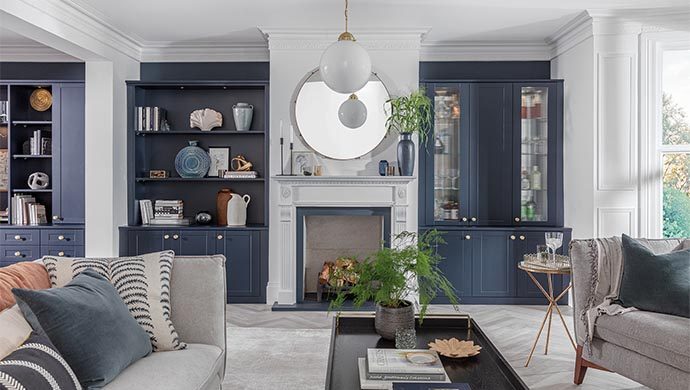
Maximize vertical space with adjustable shelving systems that can be modified as your storage needs change. Consider floor-to-ceiling solutions that make use of often-overlooked wall space.
Incorporate a mix of open and closed storage options to display decorative items while hiding everyday clutter. Use attractive boxes or baskets to maintain a cohesive look.
Final Touches
28. Textural Elements

Layer different textures throughout your space to add visual interest and depth. Mix smooth, rough, and plush surfaces through furniture upholstery, throw pillows, and decorative accessories.
Consider how different materials catch and reflect light throughout the day. Use metallic accents and glass elements to add sparkle and dimension to your space.
29. Artistic Lighting

Install unique lighting fixtures that serve as both functional elements and artistic statements. Consider pendant lights or wall sconces that add personality without consuming valuable surface space.
Layer your lighting with a mix of ambient, task, and accent options to create different moods and highlight specific areas of your room.
30. Personal Collections Display

Create thoughtful displays of personal collections using vertical space and strategic groupings. Consider rotating displays seasonally to prevent overcrowding while still showcasing your treasures.
Use shadow boxes or floating shelves to create three-dimensional displays that add depth to your walls without cluttering surfaces.
Conclusion
Creating a beautiful and functional small living room is all about making smart choices that maximize space while reflecting your personal style.
By implementing these innovative ideas, from multi-functional furniture to clever storage solutions and strategic design elements, you can transform your compact living room into a comfortable and stylish haven. Remember that successful small-space design is about quality over quantity – choose pieces that serve multiple purposes, maintain a cohesive color scheme, and create visual flow.
With thoughtful planning and creative solutions, your small living room can become a perfect example of how limited space doesn’t mean limited style.

